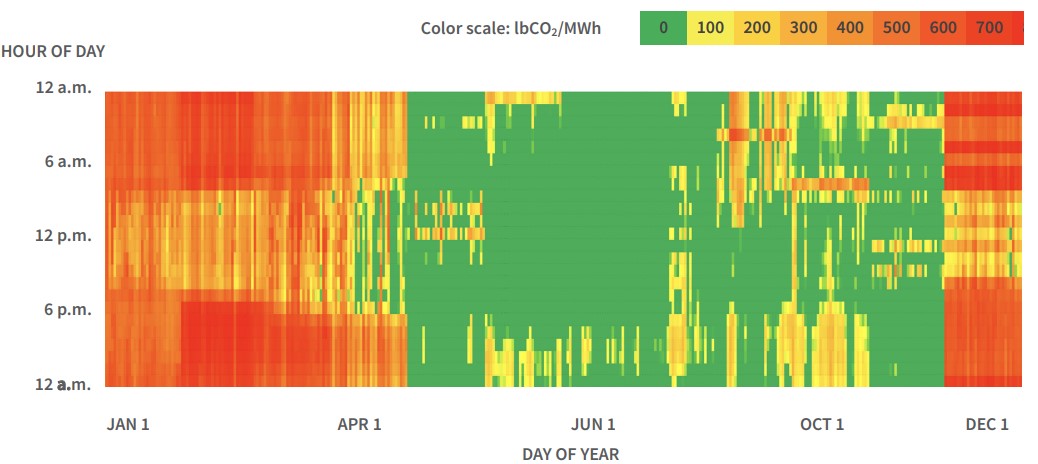
Over the past 10 years, large energy buyers including corporations and cities have taken major strides to reduce energy-related greenhouse gas emissions by setting 100% renewable energy targets and then purchasing renewable electricity to demonstrate progress on an annual basis.
U.S. corporate, commercial and industrial customers have purchased60 gigawatts (GW) of clean energy since 2014, while U.S. local governments have procured20 GW of clean energy since 2015。其中的一些主要买家已经实现their initial goals and are setting their sights on 24/7 carbon-free energy, a new approach that aims to match every hour of electricity consumption with carbon-free electricity sources at a local level to drive deeper decarbonization.
24/7 carbon-free energy is one of several approaches to decarbonizing the electric system, and thus far it has largely been driven by corporations likeGoogleandMicrosoft。Now the public sector is taking part too. In 2022, the federal government committed to achieving50 percent 24/7 carbon pollution-free electricity by 2030and five cities have committed to 24/7 carbon-free energy: Des Moines, Iowa; Ithaca, New York; South Lake Tahoe, California; Waterloo, Iowa; and Windsor Heights, Iowa.
As more cities look to advance their clean energy goals, this article breaks down how 24/7 carbon-free energy works, how local governments can get started on this approach and where they can look for support.
How is 24/7 carbon-free energy different from a 100% renewable approach?
Most cities, corporations and other large energy buyers track greenhouse gas emissions and clean energy usage on an annual basis, conducting a once-a-year calculation of total electricity used and total amount of renewable energy purchased.
Oftentimes, this energy is purchased from projects sited within grids outside where the purchaser is physically located, whenever and wherever it is cheapest. However, fully decarbonizing electricity grids requires generating clean energy around the clock when it is needed, not just during periods of abundant sunshine or wind, and integrating carbon-free energy resources on the same grid where the electricity is consumed.
A 24/7 carbon-free energy (also called hourly matching) approach is one way to incentivize alignment and investment in carbon-free technologies to fill those aforementioned gaps left by wind and solar. When more hours of energy demand are met by clean energy resources, fewer fossil fuel resources need to be activated, leading to deeper decarbonization. Hourly matching requires buyers to analyze and understand their energy load and existing renewables usage on a more granular basis, and then compare this data to the overall grid generation mix and emissions data. This can be used to produce anhourly “heat map”of the percentage of carbon-free energy or emissions intensity by day (see Figure 1, below).

This analysis is used to identify hourly gaps in carbon-free energy usage, which can help buyers more effectively procure clean energy, utilize demand-side solutions like load shifting and deploy complementary technology like energy storage.
How are cities approaching 24/7 carbon-free energy?
24/7 carbon-free energy procurement can be an efficient andcost-effective pathwayfor decarbonizing the grid, but the required data collection and analysis can be complex and time-consuming. This poses a challenge for cities, which often have limited capacity and resources for clean energy efforts.
The good news is that there are many entry points to the 24/7 carbon-free energy approach at varying levels of effort. Based on learnings and experiences from frontrunner cities in the movement, here are five steps cities can take towards hourly matching:
1. Understand hourly carbon-free energy usage
The first step is togather and analyze hourly datarelated to the city’s current and future energy load, clean energy usage and electricity grid generation mix. Some cities, like those served by a municipal utility or municipal aggregation, may have access to this data already. While hourly generation portfolios are widely available, most cities will need to either work with their utility to gain access to hourly load data or use representative data from publicly available data sources.
In many cases, a community’s load will mirror the utility’s overall hourly load profile, which is publicly available, so the city can use that as a starting point. They could also ask their utility where their load might differ considerably, which may be an easier ask than for a full dataset. Finally, cities can scale up a profile of representative building types, usingdatafrom the National Renewable Energy Laboratory.
In addition to hourly load and grid mix data, cities should understand the hourly generation data of any clean energy purchases. The three data sources mentioned above provide a city with the necessary information to develop a 24/7 carbon-free energy strategy. Organizations likeWorld Resources InstituteandRMIhave developed guidance and tools that local governments of any size can use to get started.
2.Shift demand to align with clean energy supply
The foundation of hourly matching is more closely aligning energy demand with clean energy supply. Because many cities do not have direct control over electricity generation or access to utility programs, demand-side actions like energy efficiency measures, participation in demand response programs and load shifting can be very helpful as cities approach hourly matching.
For example, cities can encourage fleet owners and residents tocharge their electric vehicles(EVs) at times when their region’s clean energy resources are at peak production. In the windy Midwest U.S., this might mean working with a utility to develop an evening“time-of-use” EV charging rateto coincide with night-time wind peak production. In sunny California, where there are grid restraints to adding more solar, cities might look to incentivizedaytime workplace charging to match peak solar production。As a bonus, these demand-side measures often reduce energy costs in the long-run for communities.
3.Maximize on-site renewables and clean energy purchases
On the supply side, all cities can increase the use of on-site renewables paired with storage to decrease the amount of electricity needed from the grid.
In deregulated markets where customers can directly procure clean energy, a city can release a request for proposal to seek bids for carbon-free energy projects such asoff-site, large-scale solar farmspaired withshared storagethat match a portion, or all, of their total hourly load. These requests for proposals might deviate from traditional clean energy procurement; for example, they might require the vendor to conduct additional data analysis or provide evidence to the timing of clean energy generation. The bid evaluation process might also require new evaluation criteria, particularly regarding the level of hourly match a bidder proposes.
On that note, many cities wonder about the cost of procuring 24/7 carbon-free energy. Peninsula Clean Energy, a community choice aggregator in San Mateo County, California, has agoal to achieve 100% 24/7 renewable energy by 2025, a particularly aggressive timeline. The municipal aggregator funded and developed anopen-source advanced modeling toolwhich shows that achieving 99% time-coincident renewable energy will result in only a 2% cost increase for Peninsula relative to its baseline scenario. While Peninsula Clean Energy has some advantages due to its location in California, the analysis has nevertheless prompted excitement from those exploring the approach.
4. Engage with utilities to develop new solutions
Cities in regulated energy markets will need to work with their utility to develop and access carbon-free resource portfolios. A few utilities, includingGeorgia PowerandDuke Energy, are already exploring dedicated 24/7 carbon-free energy supply product offerings. Others are utilizing existing renewable energy tariffs to match supply and demand by billing and crediting customers for renewables generation on an hourly, or even 15-minute interval—as is being done by Dane County, Wisconsin, through their participation in Madison Gas and Electric’sRenewable Energy Rider。
Cities that do not have access to one of these programs can consider engaging or partnering with their utility. If a city’s特许经营协议是for renegotiation, they can use this window of opportunity to discuss goals and barriers with the utility, sign aclean energy partnership agreementand negotiate favorable terms to help the city advance their energy procurement goals.
Another path is to participate in the utility’sintegrated resource plan process, which can influence the addition of clean energy resources to the grid.
5.Pass a mandate or resolution
Mandating hourly matching is a significant political step that not all cities will be able, or choose, to take. For those that do, a mandate or resolution can focus a city’s efforts by providing a timeline and justification for staffing and resourcing and give residents and partners a goal to rally around. A resolution can also signal to a utility that advanced supply-side solutions and collaboration will be needed.
If a city is ready to fully commit to hourly matching, they can work with a city council or other elected officials and community advocates to pass a 24/7 carbon-free energy mandate or resolution, like Waterloo and Windsor Heights in Iowa did. They can also sign on to theUnited Nation’s 24/7 Carbon-Free Energy Compact, as Des Moines, Ithaca and South Lake Tahoe have done.
Where can cities learn more about 24/7 carbon-free energy?
Any city can get started on the path towards matching hourly electricity supply and demand with or without a resolution, and there are many emerging resources and best practices available to help them along the way. From 2022 into early 2023, World Resources Institute supported a group of U.S. cities with 24/7 resolutions and other advanced clean energy procurement goals to learn about implementation. The slides from cityworkshops have been posted online, along with a page dedicated to thekey resources and toolsrelated to 24/7 carbon-free energy.
The global network of local governments, ICLEI–Local Governments for Sustainability, is in the process of updating their “U.S. Community Protocol for Accounting and Reporting of Greenhouse Gas Emissions”to include hourly carbon emissions data and modernize the overall protocol.The updateis expected to be complete by the end of 2023 and includes a public comment period and pilot program to test the update on a few U.S. cities.
At the international level, C40 Cities has developed awhite paperthat identifies six pathways for cities around the world to advance 24/7 carbon-free energy goals, dependent on three levers of readiness: energy resources and technology; regulation and policy; and finance. The report also highlights the variety of actions a city can take to begin working toward hourly matching.
As the recent Intergovernmental Panel on Climate Change’sSixth Assessment Report just showed, the impacts of climate change are real and devastating. We must rapidly shift off fossil fuels to clean energy. 24/7 carbon-free energy is one emerging approach that cities and other large energy buyers can take to help better align supply and demand of carbon-free energy and leverage their buying power to drive the deeper decarbonization that is needed to meet these clean energy ambitions.
This article originally appeared on Route-Fifty.com
Andrew Lightis a Clean Energy Specialist in WRI’s U.S. Energy Program.
Lacey Shaveris Senior Manager of City Clean Energy in WRI’s U.S. Energy Program.






